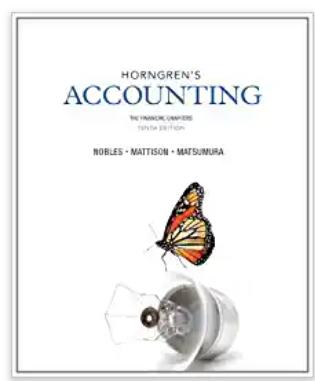Question
Rely on the research and reading you have done on hospital staffing, salaries, direct and indirect costs, and insurance reimbursement to support your work. The
Rely on the research and reading you have done on hospital staffing, salaries, direct and indirect costs, and insurance reimbursement to support your work. The purpose of this piece of the project is to determine the financial feasibility of the program and to learn whether any adjustments should be made to the strategic plan to improve the financial status of the program.
proposal -Diabetis clinic (there should be a licensed clinical staff to include physician, nurse practitioners, nurses, medical assistants, lab technicians, administrative staff, nutritionist, and social worker)
Part 3: Program Finances
Factors that determine the financial feasibility of a health care program include the cost of the facility, equipment, staff salaries, patient out-of-pocket expenses, and insurance reimbursement. Referring to the concepts practiced so far, work on the following:
- Determine how many physicians and supporting staff are needed to operate the clinic, applying the appropriate ratio of clinical and support staff per physician.
- Determine the direct costs of the program. Direct costs in this case are patient expenses, and they increase as the number of patients increase. These include:
- Physician and procedural support staff costs per patient/procedure
- Gloves, sutures, gowns, equipment, lab supplies, other supplies
- Determine the indirect costs of the program. Indirect costs are overhead costs that include but are not limited to:
- General support staff and related costs
- Electronic medical records
- Insurance and taxes
- Facility and administration
- Employee benefits such as health and life insurance, retirement plans, and fringe benefits
- Determine the equipment costs of the program. This includes items for the physician clinic that will be used for more than one year. This is in contrast to variable costs which occur per patient and include such items as gloves, syringes, needles, and gauze, and would include items such as:
- Examination tables
- Workstations
- Desks and chairs in the waiting room
- Other equipment of this nature
- Determine reimbursement for clinic services based on HCPCS/CPT codes with geographical adjustment.
- Determine net reimbursement after variable costs per patient.
- Determine how many patients the clinic will need to see (a) on average per day and (b) annually to break even on expenses.
Note: Refer to the health financial instructions and sample calculations document to help you with this part of the project.
Table 1. Staffing and Salaries
Complete Table 1 by adding the staff positions including physician specialty, nurses and support staff, and the number of positions in your clinic. Multiply the number of positions by average salary for those positions to obtain total salaries.
| Staff Position | Number of Positions | Average Salary | Total Salaries |
|---|---|---|---|
| Primary Care Physician | |||
| Nurse | |||
| Support Staff |
Total Salary:
Table 2. Fringe Benefits Expense and Total Salary Expense
These expenses have been established by the hospital system at 25% of salaries and added to salaries for Total Salary Expense.
| Factors | Dollar Amount |
|---|---|
| Total Salaries | |
| Fringe Benefit Expense 25% of Salaries |
Total Salary Expense w/ Fringe Benefits:
Table 3. Overhead (Indirect) Costs and Total Fixed Practice Costs
Begin with total salaries including fringe benefits. Multiply that amount by 40% (0.40) and combine the 2 numbers for total fixed practice costs. These costs do not vary based on the number of patients.
| Cost Factors | Dollar Amount |
|---|---|
| Overhead Costs 40% of Total Salary Expense | |
| Total Salaries Expense | |
| Overhead Costs 40% of Total Salary Expense |
Total Overhead and Fixed Costs:
Table 4. Equipment Costs
These items will be used by the clinic for 5 years so the costs will be divided equally over 5 years (depreciation).
| Cost Factors | Dollar Amount |
|---|---|
| Total Equipment Cost | |
| Depreciated Equipment Cost (cost for year one) |
Total Clinic Costs (for year one including salaries, overhead, and equipment costs):
Table 5. RVU and Reimbursement Calculation
The cost of physician care varies in different locations, as do the cost of operating a practice and the rates of physician malpractice claims. In addition, each year Medicare adjusts the conversion rate either up or down.
| Category | RVU | GCI | Total RVU |
|---|---|---|---|
Totals
- RVU:
- GCI:
- Total RVU:
Table 6. Variable Costs and Net Reimbursement
To complete Table 6, multiply reimbursement per visit by 10% (0.10) and subtract this number from reimbursement to obtain net reimbursement per patient.
| Cost Factors | Dollar Amount |
|---|---|
| Reimbursement per visit | |
| Variable cost per patient 10% |
Net Reimbursement per patient:
7. Breakeven Analysis
To calculate the number of patients needed to break even, divide total practice costs by net reimbursement. To calculate the number of patients per day, divide the total number of patients for an annual breakeven number by the number of days the practice is open. Enter text below.
Step by Step Solution
There are 3 Steps involved in it
Step: 1

Get Instant Access to Expert-Tailored Solutions
See step-by-step solutions with expert insights and AI powered tools for academic success
Step: 2

Step: 3

Ace Your Homework with AI
Get the answers you need in no time with our AI-driven, step-by-step assistance
Get Started


